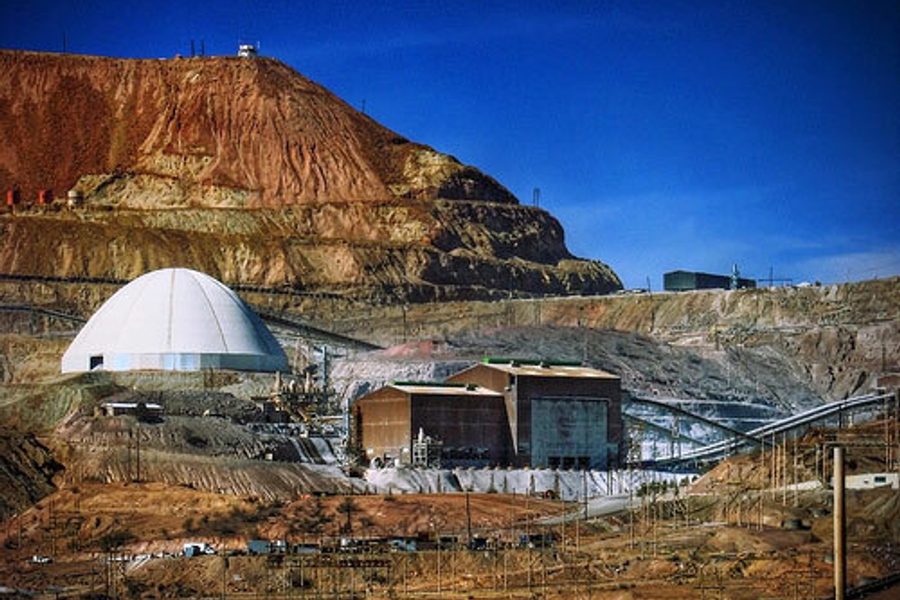
Mexican miners at Cananea, one of the world’s largest open pit copper mines and a cradle of the Mexican Revolution, have been on strike since July 2007 in a brutal stand-off with the company Grupo Mexico and the government. The strike has elicited solidarity strikes and actions across the country and is a key piece of a larger battle for union rights and democracy in Mexico.
The miners union and union democracy in general suffered a serious blow as a federal court decided last month that Grupo Mexico can fire the striking workers and terminate their labor agreement because the mine has become “inoperable” due to neglect and sabotage during the strike. The website LabourStart says the court decision “effectively eliminat(es) the right to strike in Mexico.”
Miners originally went on strike over extreme health and safety problems, and they have long charged that the company intentionally allowed conditions to deteriorate to try to break the union. Now, a serious battle could be brewing: The miners union has vowed to continue striking until a fair labor agreement is reached, and the government has threatened to use force to evict the miners.
This month Grupo Mexico asked the Mexican army to enter the mine to remove explosives, a request the union saw as intimidation.
The company, which says it has lost $3 billion because of the strike, still plans to reopen the mine. Earlier this year they offered to buy out striking miners, an offer refused by the National Revolutionary Mine and Metal Workers Union of Mexico (SNTMMSRM).
The government’s support of Grupo Mexico in the labor dispute is inextricably linked with the prosecution of the former head of the powerful miners union, Napoleon Gomez Urrutia, who was charged with embezzling $55 million from the union and is now in exile in Canada. Supporters of Gomez Urrutia say the charges were trumped up as a way to defang the miners union and gut powerful independent unionism in general. The Mexican government has asked Canada to extradite Gomez Urrutia. Interestingly, Canada is home to numerous major mining companies doing business – often in highly contentious situations – in Mexico and other parts of Latin America.
As Jessica Pupovac and I described in a 2008 story for In These Times, the strike has viciously divided the town of Cananea, in forested hills about 60 miles south of the Arizona-Mexico border. Local union leaders told us they were determined to fight to the bitter end, even as families were torn apart and physical attacks were common in the town built around the mine and also plagued by drug cartel violence.
Labor advocates fear that the February 11 court decision will clear the way for government troops to forcibly remove striking miners. The military descended on protesting Cananea miners in 1989, when it was privatized in a sweetheart deal between notoriously corrupt then-president Carlos Salinas de Gortari and Grupo Mexico owner Jorge Larrea (father of current scion German Larrea). Then on Jan. 11, 2008, local police attacked miners with tear gas and rubber bullets after a federal arbitration board ruled the strike illegal. That decision was soon overturned, and the strike was allowed to legally continue…until the February decision.
For more than a century, the mine has been highly symbolic in the country.
From our 2008 story:
At the turn of the 20th century, Col. William Green, a U.S. citizen who owned the mine, paid his Mexican employees far less than his American workers. In 1906, the mine’s workers — organized by anarchist Ricardo Flores Magon — staged a strike that garnered support from the Industrial Workers of the World. Green ultimately crushed the miners’ rebellion with help from Mexico’s then-dictator Porfirio Diaz and the Arizona Rangers, a law enforcement group formed to apprehend outlaws. But the Cananea strike — and the 30 Mexican and six American workers who died during it — became a rallying cry for the 1910 Mexican Revolution.
In 1971, Mexico nationalized Cananea’s massive copper mine. But in 1989, the government of the notoriously corrupt President Carlos Salinas de Gortari sold it for $525 million (in today’s dollars) to German Larrea, the scion of the multinational mining company Grupo Mexico, and currently the country’s third-richest man. His family’s estimated net worth is $7.3 billion. Their assets include not only mining interests in Mexico and Peru, but also Mexico’s largest railroad company and its second-largest movie theater chain.
U.S. and international unions including the International Metalworkers’ Federation and the United Steelworkers of America have been highly supportive of the striking Mexican miners.
In the wake of last month’s decision, international solidarity groups are calling on U.S. citizens to send emails to Mexican government officials.
On International Workers Day last year, miners and others around the nation shouted “Todos Somos Cananea!” (“We are all Cananea!”) This rallying cry will likely resurface with even more relevance this year — the 100th anniversary of the Mexican Revolution, which sprouted from seeds sown in Cananea.
Kari Lydersen is a Chicago-based journalist, author and assistant professor at Northwestern University, where she leads the investigative specialization at the Medill School of Journalism, Media, Integrated Marketing Communications. Her books include Mayor 1%: Rahm Emanuel and the Rise of Chicago’s 99%.








